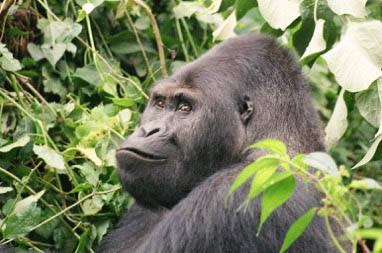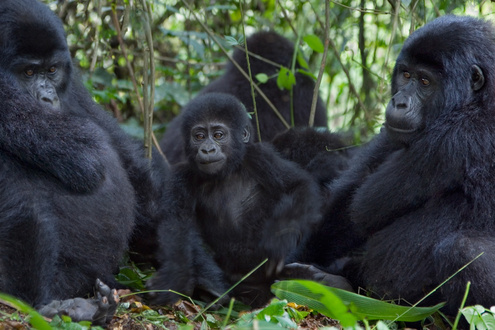Recently, a bizarre question took hold of social media: Could 100 men take on a gorilla in a fight? What…

One of the adult females in Raha’s wider family circle has welcomed a new baby.
Raha, the adopted gorilla of the Gorilla Organization’s generous supporters, has seen a lot of social comings and goings over the past few years as the wild mountain gorilla groups of the Bwindi Impenetrable Forest have divided up and merged. New mum Rotary has spent some time alongside Raha in the Bweza group while also settling into the Mishaya group.
Rangers patrolling the Bwindi forests have confirmed that mother and baby are doing well, though they have yet to get close enough to determine if the latest arrival is male or female. This is a second infant for 15-year-old Rotary. The birth also means that 35-year-old Shida has become a grandmother for the first time.
Under the close leadership of silverback Mishaya, all of the group are staying close to the new baby, and mother Rotary has been comfortable enough to let tourists come close.
Find out how you can adopt Raha and help a mountain gorilla family survive.

Recently, a bizarre question took hold of social media: Could 100 men take on a gorilla in a fight? What…

On 27 April 2025, Sonam Modhwadia took on the legendary TCS London Marathon, running every mile with purpose, in support…

A surge in Mpox cases across the Democratic Republic of the Congo has triggered an urgent conservation response to protect…
The Gorilla Organization’s Tuver Wundi went to meet with one of the guides looking after the Binyido group, Lameck Monday. He’s been working in the park for ten years and has seen first-hand how tourism has helped transform the lives of the communities living alongside the gorilla forests.
With 20% of all tourist revenues redistributed locally, and thanks to projects such as the Gorilla Organization’s long-standing community conservation programmes, the people of the Bwindi region have less reason to trespass into the park to poach or collect firewood.
For the Binyido family and the 450 other mountain gorillas living here, that means the chance to live and thrive in peace.
This story was originally published in the Summer 2023 edition of Digit News. Read the full newsletter here.

Recently, a bizarre question took hold of social media: Could 100 men take on a gorilla in a fight? What…

On 27 April 2025, Sonam Modhwadia took on the legendary TCS London Marathon, running every mile with purpose, in support…

A surge in Mpox cases across the Democratic Republic of the Congo has triggered an urgent conservation response to protect…
As violence rages, the endangered mountain gorillas of the Virunga National Park have been left more vulnerable than even as rangers struggle to reach them.
At its height, fighting was reported just 20km north of Goma and also to the west of the city, too. The conflict has made the N2 road too treacherous to use. The road is not only a lifeline for trade and resources. It’s also the main – often the only – way of getting to the National Park from Goma.
Without the road, rangers are unable to reach the gorillas they are committed to protecting. And Henry and his team cannot drive to the projects they are equally committed to running.


But where there’s a will, there’s a way. For more than 15 years, Henry Cirhuza has led the Gorilla Organization’s projects in DR Congo. They really have seen it all. From earthquakes and the 2021 eruption of the Mount Nyiragongo volcano which looms large over the region through to public health emergencies and blackouts, they have kept their conservation and development projects going whatever the challenge. And so, over recent months, they have found a way to adapt to a new problem, the encirclement of Goma by rebel forces.
Instead, the team have started taking to the water. Though more time consuming, chartering a boat across Lake Kivu is a far safer way to get to the projects. “We need to take more precautions to go supervise our projects these days,” Henry explains. “The city is almost completely surrounded, the roads are dangerous, but we still need to be there, to reassure our colleagues and keep our important work going.”
Given all they have endured over the years, the attitude among the citizens of Goma is one of resilience and slight optimism. For now at least, travelling by water remains the safest way to get from the Goma Resource Centre to the projects, allowing the team to maintain their long and proud record of always being there for the communities that rely on them.
This story was originally published in the Summer 2023 edition of Digit News. Read the full newsletter here.

Recently, a bizarre question took hold of social media: Could 100 men take on a gorilla in a fight? What…

On 27 April 2025, Sonam Modhwadia took on the legendary TCS London Marathon, running every mile with purpose, in support…

A surge in Mpox cases across the Democratic Republic of the Congo has triggered an urgent conservation response to protect…
Dr Gladys Kalema-Zikusoka is one of the most famous naturalists in the world. The winner of countless awards, a National Geographic Explorer and a United Nations ‘Champion of the Earth’, she is a pioneer connecting human health and gorilla conservation. She’s also a valued Trustee of the Gorilla Organization, a role many years in the making. Dr Kalema-Zikusoka picks up the story…
“As I celebrate the release of my book “Walking with Gorillas”, I have to thank Jillian Miller and The Gorilla Organization for all the great support they have given me on my journey. This began in the 1990s when as a veterinary student at the Royal Veterinary College in London, they gave me the opportunity to volunteer and so I spent my days stuffing envelopes to send to donors. When I was appointed as the first veterinarian for Uganda Wildlife Authority in 1996, the Gorilla Organization donated the first darting equipment. It arrived came just in time to successfully handle the first fatal disease outbreak in the- then critically endangered mountain gorillas of Bwindi Impenetrable National Park”
Since then, Dr Kalema-Zikusoka has set up her own NGO, Conservation Through Public Health, and continues to advocate for better futures for both gorillas and the people they live alongside. In recognition of her work, Gladys has most recently been awarded an Honorary Doctorate from the Royal College of Veterinary Surgeons in London.
This story was originally published in the Summer 2023 edition of Digit News. Read the full newsletter here.

Recently, a bizarre question took hold of social media: Could 100 men take on a gorilla in a fight? What…

On 27 April 2025, Sonam Modhwadia took on the legendary TCS London Marathon, running every mile with purpose, in support…

A surge in Mpox cases across the Democratic Republic of the Congo has triggered an urgent conservation response to protect…
Its name means “mountain of the spirits”, so called because the indigenous Baswagha clan used to talk of dark-haired spirit animals living deep in the forests.
For almost a decade, the Gorilla Organization ran a pioneering conservation project here. Despite the immense logistical challenges, not to mention the high levels of insecurity, the team led by Jean-Claude Kyungu managed to build strong working relations with local communities and bringing levels of poaching right down. More importantly, the project succeeded in raising the numbers of ‘spirit animals’, in reality Grauer’s (or eastern lowland) gorillas up from around just 12 to more than 26.
Over recent years, however, numbers have been steadily declining. The area has fallen under the control of rebel militia on countless occasions. Poaching has been rife, and gorillas killed. And a serious decline in breeding age females has pushed the whole population to the brink. Tragically, in March 2023, the insecurity claimed the life of Freddy Mahamba, the first ranger to be employed by the Gorilla Organization to guard the Grauer’s gorillas. Mahamba was the 176th ranger to die in the line of duty since the National Park was created.
But still, there’s reason for some tempered optimism. After a thorough feasibility study, plans are underway to relocate two more female gorillas to the mountain. Translocation as it’s called in conservation circles comes with no guarantees. Nevertheless, following the birth of two gorilla babies on Mount Tshiaberimu over the past three years, hopes are high that the incomers will help kickstart recovery, providing the ideal legacy for Mahamba and all the people who have given so much to preserve the habitat and wildlife of this mystical mountain.
This story was originally published in the Summer 2023 edition of Digit News. Read the full newsletter here.

Recently, a bizarre question took hold of social media: Could 100 men take on a gorilla in a fight? What…

On 27 April 2025, Sonam Modhwadia took on the legendary TCS London Marathon, running every mile with purpose, in support…

A surge in Mpox cases across the Democratic Republic of the Congo has triggered an urgent conservation response to protect…
This first line of defence is where the difference between survival and extinction is made. It’s determined and resilient. But it’s also vulnerable. Especially in the face of natural disasters like the mudslides that hit parts of Congo, as well as neighbouring Rwanda and Uganda in May.
The rain started falling in the early evening. In Kalehe, a rural, underdeveloped area of DR Congo and the base for gorilla conservation efforts in the region, it was market time. Buyers and sellers took shelter in whatever home they could. But the wall of mud was just too big and powerful. Stones weighing several tons each washed over the communities, covering an area 1.5km long and 500 metres wide. In some places, the mud was 15 metres deep.
“What we witnessed was simply beyond our comprehension,” Henry Cirhuza, Project Manager in Congo, reported when the earth had stopped moving. Whole communities had been destroyed. Hundreds of people were dead, including two valued beneficiaries working at the Gorilla Organization’s tree-planting projects. It’s these projects that hold the key to addressing the root causes of the threats facing gorillas in the wild, namely habitat loss and a lack of sustainable livelihoods for local communities. To make matters even worse, the vital road link connecting the villages of Kalehe to the Virunga National Park was made impassable. As communities counted the cost of this latest tragedy, rangers were unable to get to their posts.
Once again, as fear and uncertainty swept the region, the endangered mountain gorillas were left unguarded and highly vulnerable.


A green buffer destroyed
The mudslides were shocking. But they were not unexpected. Indeed, this was a tragedy a long time in the making.
The destruction of the forests of this part of Africa has been ruthless and relentless. Ironically, Bushushu, where the Gorilla Organization has established a tree-planting nursery, is also a hub of charcoal trading. Huge areas of forest are destroyed to feed the largely-illegal trade. For the endangered mountain gorillas, it means their habitat is steadily shrinking, bringing them closer to people and increasing the risk of harmful encounters. The loss of trees also increases the risk of flooding and landslides. The soil in this part of Africa is sandy and fragile. Without trees to serve as a natural defence, water and mud can cascade downhill uninterrupted, bringing death and destruction like the communities witnessed in May.
Even though they have been hit hard, the affected communities are determined to rebuild. Such resilience is shared by the teams at the Gorilla Organization’s tree nurseries. This first line of defence for the gorillas is quickly being rebuilt. At Nyamubuki, the clear-up operation is well underway and work will begin again soon, with the aim of planting as many as 2 million trees to provide a buffer between people and gorillas. The work has already caught the attention of the European Union’s representatives in Kinshasa and could be replicated on an even-bigger scale.
Hand-in-hand with the reforestation efforts, community development programmes will be vital in reducing demand for charcoal and giving people a chance to earn a living without having to rely on the natural resources of the gorilla habitat. So too will empowerment. For the Batwa village of Biizi in Uganda, hope lies in youth. Elias, whose uncle was badly injured in the landslides, is the first member of his community to graduate from university. With the Gorilla Organization’s support, the Batwa people are slowly going from marginalised to empowered, equipped with the resilience to overcome future setbacks and the knowledge needed to reduce their likelihood, even if just a little bit.
This story was originally published in the Summer 2023 edition of Digit News. Read the full newsletter here.

Recently, a bizarre question took hold of social media: Could 100 men take on a gorilla in a fight? What…

On 27 April 2025, Sonam Modhwadia took on the legendary TCS London Marathon, running every mile with purpose, in support…

A surge in Mpox cases across the Democratic Republic of the Congo has triggered an urgent conservation response to protect…